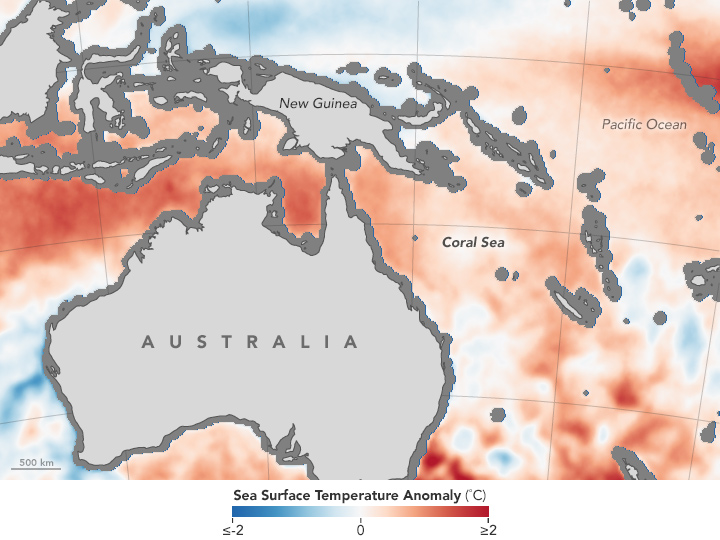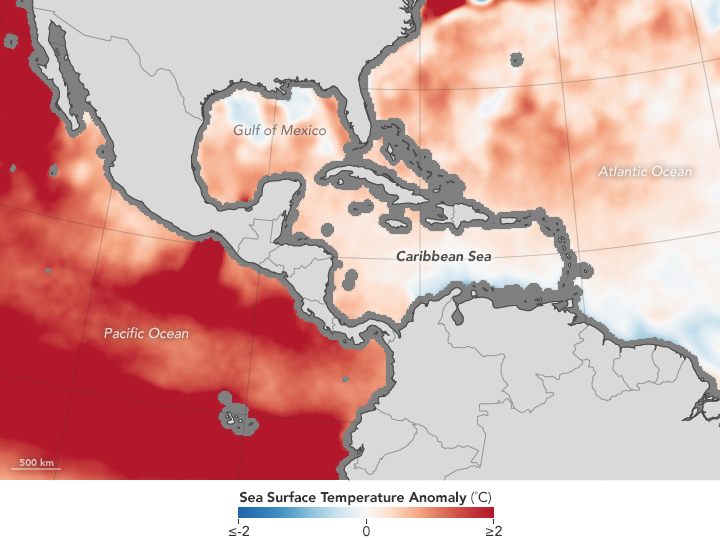


For all of the apparent hardness of their skeletons, corals are rather fragile. Corals thrive under very specific conditions; in particular, they grow best within a small window of temperatures. If the water gets too hot or too cold, corals start to bleach and sometimes die.
The past two years have been the two hottest in the global temperature record, and coral reefs around the world are suffering because of it. The potent El Niño has amplified the problem. As a result, national and international science agencies have declared one of the worst global coral bleaching events on record.
“We are currently experiencing the longest global coral bleaching event ever observed,” said Mark Eakin, coordinator of NOAA’s Coral Reef Watch, in a February 2016 statement. “We may be looking at a 2- to 2.5-year-long event. Some areas have already seen bleaching two years in a row.”
Bleaching occurs when the algae that live inside corals (and give them some of their colors) are expelled due to stress, such as higher-than-normal water temperatures or pollution. The loss of the algae means the loss of a food source for the corals. Under extreme bleaching, corals become more susceptible to disease. Bleaching does not necessarily mean death for a reef, but it can often lead to it.
The images above and below are maps of sea surface temperature anomalies (SSTAs) in various regions over the past year. The maps do not depict absolute temperatures; instead, they show how much water temperatures were above (red) or below (blue) the long-term average for the same months from 2003 to 2012. Gray areas are too close to land and coastal shallows for a clear signal in this data set.
The map at the top of this page shows sea surface temperature anomalies for the southwestern Pacific Ocean for February and March 2016. The map below depicts equatorial Atlantic, Caribbean, and Pacific waters around the Americas in October and November 2015. The final map is a global view of SSTAs from November 2015 through February 2016, the peak of this winter’s El Niño.

The maps were built with data from the Microwave Optimally Interpolated SST product, a NASA-supported effort at Remote Sensing Systems. The research team combines measurements from the U.S. Navy’s WindSAT instrument on the Coriolis satellite and the AMSR2 instrument on Japan’s GCOM-W. The sensors observe emissions of microwaves and infrared light from the sea surface, capturing the temperature of the top few millimeters of the water.
Temperatures on these maps show above-average readings, but do not necessarily look extreme in the areas around the reefs. But keep in mind that corals are sensitive to relatively minor changes in temperature. Researchers from NOAA also point out that sustained heat stress over a long period of time—weeks to months—is more damaging than brief, extreme events.
Researchers from Australia’s Coral Bleaching Taskforce have reported that nearly 93 percent of the Great Barrier Reef has been affected in some way by the bleaching event. Temperatures around the reef most recently peaked in February and March 2016. After conducting aerial and in-water surveys, scientists observed that 81 percent of the reefs between Cairns, Australia, and Papua-New Guinea have been severely bleached, with another 18 percent partially bleached. Some reports suggest 50 percent of the corals might be dead already. Along the central latitudes of the reef system, 33 percent of the reefs were severely bleached, with another 56 partly affected. In the southernmost reaches, 1 percent was severely bleached and 74 percent had some level of distress. The central and southern portions were actually aided a bit by Cyclone Winston. The severe storm churned up enough cold water to reduce surface water temperatures and moderate the bleaching.
In the Caribbean and the reefs of the Florida Keys, bleaching events were most severe in the fall of 2015. Reefs around the Hawaiian Islands, Fiji, and other Pacific islands have been severely stressed and bleached. With 2016 global temperatures already setting records, there is concern that bleaching could occur again in 2016.

NASA Earth Observatory image by Jesse Allen, using multi-satellite microwave sea surface temperature data from Remote Sensing Systems. Caption by Michael Carlowicz.